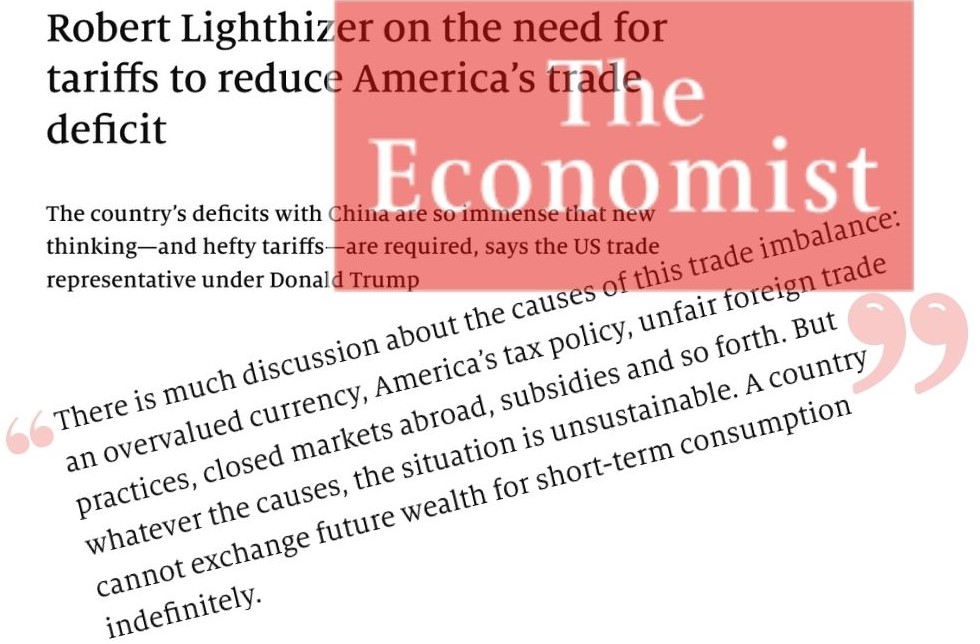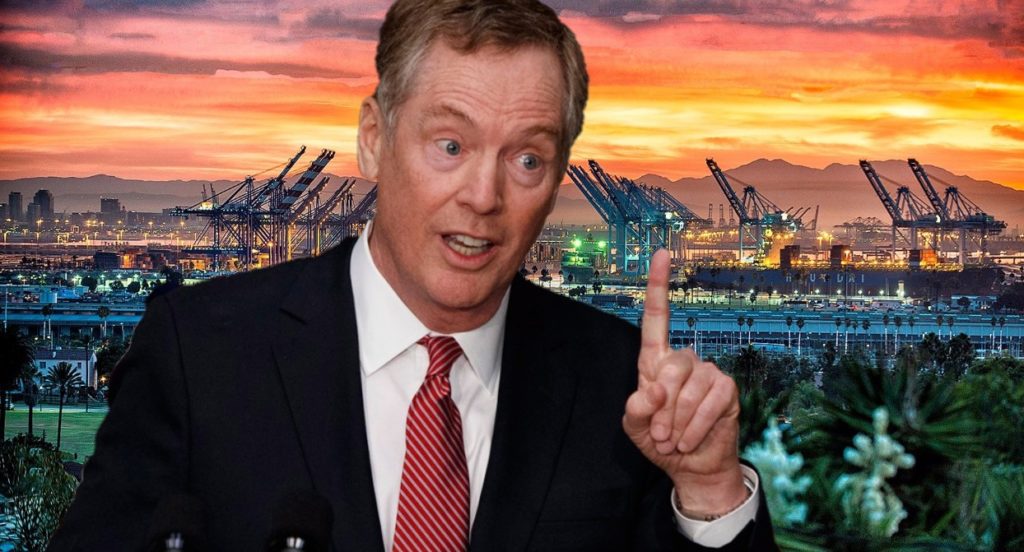Former US Trade Ambassador Robert Lighthizer recently published an op-ed in The Economist magazine where he advocated the reconsideration of tariffs as an important trade and economic policy tool, and called out dollar super strength as a reason for consistent trade imbalances.
Lighthizer said international trade deals have “largely failed the America over the past three decades.” He likely pulled that bit if information from the International Trade Commission’s recent review of some of the country’s biggest bilateral trade agreements, including NAFTA, which showed the benefits all went to global corporations. Small to midsized companies also lost out, and blue-collar workers lost out even more.
That The Economist published Lighthizer’s opinion is significant. The Economist has been a global champion for free trade and against tariffs since its London founding in 1843. Its globalist readership does not read it for the paper’s support of the “working man”.
Lighthizer wrote that the scale of the trade deficit problem is hard to comprehend, and a return to massive trade deals like the Transpacific Partnership are a dead-end if you want to promote economic equality and reshore critical supply chains.
Lighthizer begins by saying the U.S. has rung up over $12 trillion in accumulated global deficits since 2001. To put that into perspective, that is roughly the entirety of the Chinese economy, and 10 years of Mexico’s economic output.
Thirty years ago the trade deficit was around $80 billion a year, but today it is eight times larger and likely to grow even bigger this year thanks in part to trade policies, multinational corporate interest in labor, tax and regulatory arbitrage, and a strong dollar. As a result, we will exceed a record $1 trillion goods deficit this year unless the economy stalls out between now and Christmas.
Americans see a problem.
As competition between the United States and China intensifies, more Americans now think China is more powerful economically than the U.S., a reversal from two years ago when a majority said the United States was stronger, according to a survey released Thursday by the Chicago Council on Global Affairs.
“The important issue is not America’s annual global trade deficit nor its bilateral trade imbalances but the decades-long trend of enormous deficits without any surpluses. The country has literally handed over trillions of dollars of its wealth to other countries, with China getting the lion’s share. This was never supposed to be able to happen under the theory of trade espoused by economists. But it has,” Lighthizer wrote.
Here are some of the main takeaways from the op-ed, which can be viewed in its entirety here.
Big Imports. Big Debts.
America is by far the largest importer in the world—and that has contributed to making it the world’s largest debtor. The U.S. has been running trade deficits averaging well over $500 billion per a year (or 3%-5% of GDP) for more than 20 years and the figure is growing. Trade deficits must be considered cumulatively; not annually in isolation, Lighthizer said. Classical trade theory said our trade balance should level out — our currency would get cheaper, making us better at exports, and closing the gap with other countries. That never happened.
“Deficits are bad for a number of reasons. They can be a drag on economic growth, they can negatively affect the composition of the labor force and wages, and they can lead to macroeconomic distortions. Perhaps more important, with these persistent deficits America has shipped trillions of dollars of its wealth to foreign countries in return for goods, often short-term consumer goods. Those dollars don’t just sit in a foreign vault—our trading partners use them to purchase American assets and debt instruments. In a real sense, America is trading ownership of its productive assets and economic future for short-term consumption.” — Robert Lighthizer, The Economist magazine, October 5, 2021.
Worth noting, the purchase of those securities — stocks, corporate bonds and Treasury bonds – make for greater demand for dollar assets, driving up the strength of the dollar and making American products much more expensive abroad than their foreign counterparts.
#Lighthizer highlights the need to deal with America's trade deficit. I served on the US Trade Deficit Review Commission and Democrats made clear that it's a jobs, national security and economic strength issue. This should be a bipartisan issue. https://t.co/lwxYOs98gJ
— Michael Wessel (@MWesselDC) October 7, 2021
An Overvalued Dollar
Wall Street hates a weak dollar. Others think a super-strong dollar is a sign of economic strength. That is not necessarily the case. What it is a sign of is greater demand for dollar securities. The dollar was strong during the Great Recession. And the dollar was even stronger when Europe had negative-yielding interest rates. Wall Street likes a strong dollar because it means more Europeans and Japanese buying their financial products.
But a strong dollar is at the heart of the trade deficit.

Lighthizer called for a “market access charge” to slow foreign inflows into U.S. securities, leading to a super strong dollar versus every other major global competitor, including those in Europe.
“Most of the (foreign capital) inflow is not for new factories or manufacturing. Indeed foreign direct investment is a tiny fraction of all capital flows into the country, on the order of 1%. These investments bid up our equity markets but also transfer to the buyer a right to future profits and national wealth,” Lighthizer wrote.
To reign in the dollar, Lighthizer mentioned the “market-access charge”. He described it this way:
“Essentially, the Federal Reserve would impose a variable tax on capital flows into the country from foreign persons. It would raise or lower the tax to disincentivise foreigners from buying American assets; this drop in demand for the assets would lower the value of the dollar. The idea is that this would “realign” (that is to say, “weaken”) the dollar and bring about trade balance.”
Lighthizer said that a MAC might be complicated, but here is where it will not.
Any U.S. financial institution, upon receiving a transfer of money from abroad, would automatically collect the MAC at the current rate on the incoming money, then transfer the charge electronically to the Treasury. It’s a tax on foreign portfolio inflows, not on U.S. investors investing in U.S. or foreign investments.
It would discourage speculative financial investments that lead to bubbles. As the MAC charge cuts into the difference in yield between what U.S. Treasurys and dividends pay and what other big markets pay – namely Europe and Japan — it discourages dollar inflows and keeps the dollar in check or weakens it. This is just one factor driving demand for dollars.
Raise Tariffs Across the Board, At Least Temporarily
Lighthizer thinks that another solution to reducing the trade deficit is a temporary tariff on all imports and gradually increase it or decrease it depending on the level of the deficit. For example, a 10% tariff could be applied to all imports. Right now that tariff is around 3%
“If the deficit did not go down in a couple of years, the tariff would be increased to 20% for several more years. If this did not have the needed effect it might go up to 30%. The program would make exceptions for critical goods. When the deficit was substantially reduced, the tariffs would also decline and eventually be eliminated,” Lighthizer wrote.
He said changing the tariff schedule and taxing dollar inflows going to buy securities would reduce the trade deficit.
Any downsides to a MAC charge and tariff increases “would be temporary and surely would be outweighed by the benefits of balanced trade,” he said.
Trump, Biden and Tariffs
America’s trade situation has contributed to a hollowing out of manufacturing capabilities, loss of millions of jobs, and wealth inequality. It has created to economic deserts nationwide, small and midsized towns that once had a manufacturing base, most of it lost to Mexico and China.
“There is a strong sense in the American body politic that something is very wrong. This is part of the reason why Donald Trump was elected president and populism is on the rise. Economists can debate the importance of savings rates and productivity but voters have their own instinctive reaction. President Trump followed through on his campaign promise in 2016 and radically changed the trade agenda. He raised tariffs… In fact, both presidential candidates ran on essentially the same trade platform. Joe Biden abandoned his past support for comprehensive trade deals like TPP,” Lighthizer wrote.
International trade has helped some parts of the United States. The country is the second-largest exporting nation after China, and overseas markets help to support millions of American jobs. The profitability of the agricultural sector depends a lot on exports, much of it to China. The country’s services sectors run substantial surpluses every year – most of this through the selling of software, the collection of IP fees, foreign students studying here, and financial services.
Still, Americans favor protectionist measures. The 2021 Chicago Council Survey found that protecting U.S. jobs ranks ahead of other Washington DC policy favorites, including fighting the Covid-19 pandemic, international terrorism, and climate change.
Moreover, a majority of survey respondents said they do not consider current policies beneficial to working-class and middle-class Americans. Large majorities said that U.S. trade policies help large companies and wealthy Americans.
“If wealth is the life-force of an economy, America’s persistent, massive trade deficit means it is being bled to death,” Lighthizer said.














